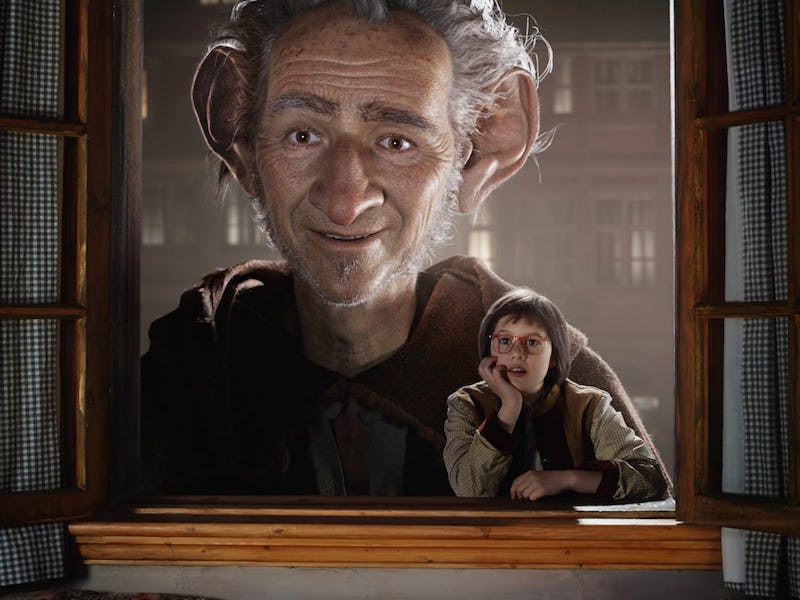'The BFG' Is the 'E.T.' Sequel Steven Spielberg Never Made
The filmmaker's latest could also be a kind of soft reboot, of sorts.

In 1982, E.T. The Extra Terrestrial solidified Steven Spielberg as the heartfelt blockbuster king. Through a string of wonderfully cinematic and creative masterpieces like Jaws, Close Encounters of the Third Kind, and Raiders of the Lost Ark (let’s not mention 1941), Spielberg created a series of classic stories that made a killing at the box office. But as he banked hit after hit, he avoided one thing: the sequel.
Sure, early 1980s Hollywood wasn’t clamoring for cinematic universes like it is today, but there were opportunities to follow up his big smashes. He bowed out of directing Jaws 2, and after cooking up an E.T. sequel with screenwriter Melissa Mathison, he eventually abandoned it. Now, 34 years later, Spielberg and Mathison have made a covert semi-sequel: Their adaptation of Roald Dahl’s The BFG, which hits theaters on July 1.
From what we know of it, the planned E.T. sequel would have been very, very bad. Subtitled Nocturnal Fears, the proposed sequel features evil carnivorous aliens, led by a creature named Korel, who hold other alien varieties hostage in their ship and visit Earth to try and eradicate E.T.’s species. Eventually they capture and torture the original movie’s protagonist, Elliott (played in Spielberg’s movie by Henry Thomas) when he thinks a recognizable alien signal nearby belongs to his benign alien friend. Elliott’s cries for help eventually summon E.T. back to Earth, and the alien frees Elliott and the other innocent captive aliens. Then the little guy reprograms Korel’s ship to fly off into a far flung corner of the galaxy before he leaves Elliott and Earth again.
Even though Spielberg didn’t make that movie, he was evidently not done telling the story of characters finding their true adolescent identity through the unlikeliest of friends. The BFG’s tale of a Big Friendly Giant (Mark Rylance) who befriends a British orphan named Sophie (newcomer Ruby Barnhill) is filled with the normal Spielberg schmaltz, and for the most part it works. But the marked collaboration between Spielberg and Mathison (who passed away last year), along with the themes of both The BFG and E.T. (not to mention the acronym titles) make for such a cohesive pairing that the former works best as the true E.T. sequel Spielberg never made. Similarities abound.
Seemingly bizarre friendships are at the core of both films, as their plots revolve almost entirely around unlikely friends. Elliott realizes the alien he found in his backyard is his one true friend, and Sophie learns to trust the 24-foot humanoid creature with her life. The BFG is the straightforward tale of a lonely girl whisked away to another place and realizing the world is much bigger and stranger than she could have realized. Swap out Sophie and the Giant Country and insert Elliott and suburban 1980s California, and you’ve got E.T.
Even the childlike speech patterns of both titular characters are similar. The dyslexic wordplay of the BFG, with his “How whoopsey-splunkers” or “How absolutely squiffling” matches the toddler-like gobbldiegook gradually assembled into simple word phrases by E.T., his predecessor as “other.” Rylance’s motion capture performance is wondrously goofy, but each movie features an ostensible special effect as lead character.
There are no true villains in either movie, just circumstances each lead pair must overcome. When in Giant Country, Sophie learns of an evil band of bully giants led by one called the Fleshlumpeater (Jemaine Clement), who seem to tease the BFG and that’s about it. The grisly details of some of the giants killing and eating small children, which they call “human beans,” is largely implied, mostly because Spielberg’s sincerity makes for odd bedfellows with Dahl’s more macabre sensibilities. The same goes for the ubiquitous government threats in E.T., which ends up actually saving the little alien instead of hurting him.
Whereas The BFG succeed most in extending the story of E.T. is in its otherworldly setting; E.T. is limited to the suburbs. And it’s not just for special effects; when she travels to her companion’s home world, she realizes that her friendly giant friend can stand in for the family she doesn’t have back home. After E.T. books it at the end of that movie, Elliott is left to ponder what E.T. used to mean to him. It’s admittedly a potentially unreal fairy tale implication, but at least Sophie can be comfortable with her identity knowing the BFG is always there to help. E.T. could phone home or to Elliott all he wanted, but their finger-to-finger connection was no more.